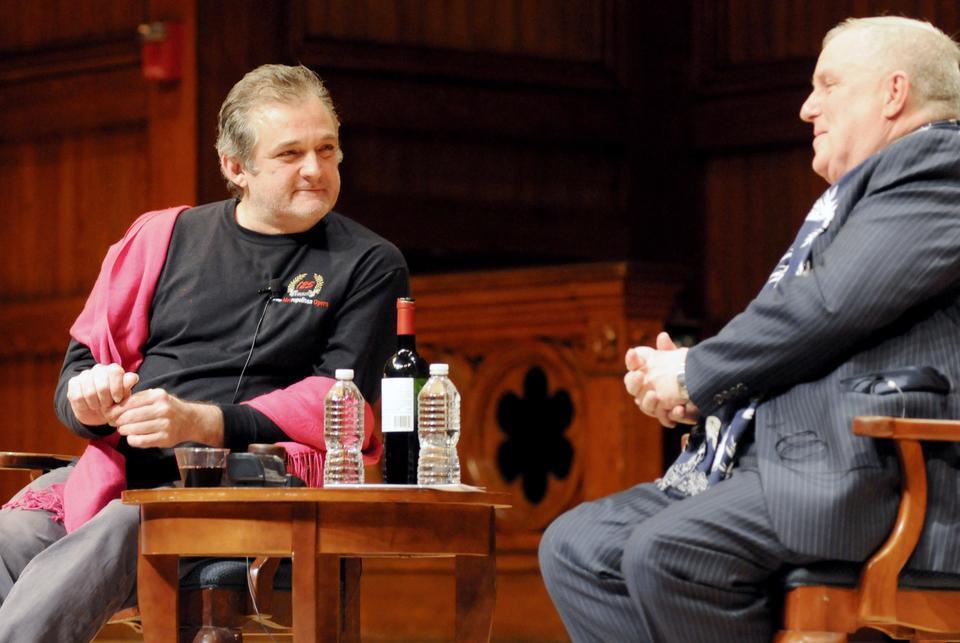
News
Pro-Palestine Encampment Represents First Major Test for Harvard President Alan Garber

News
Israeli PM Benjamin Netanyahu Condemns Antisemitism at U.S. Colleges Amid Encampment at Harvard

News
‘A Joke’: Nikole Hannah-Jones Says Harvard Should Spend More on Legacy of Slavery Initiative

News
Massachusetts ACLU Demands Harvard Reinstate PSC in Letter

News
LIVE UPDATES: Pro-Palestine Protesters Begin Encampment in Harvard Yard
Morris Dances with Wolfgang

When choreographer Mark Morris rehearses in his studio, he looks like he is conducting an orchestra. Walking across the wooden floor with a brown shawl wrapped around his shoulders and New Balance sneakers on his feet, Morris points first to the piano, then to the dancers. A musical scale falls, then one of the dancers falls too; but the two movements don’t echo, they come together.
“I don’t want people to look like they are dancing in response to something,” Morris explained to a crowd in Sanders Theater last Wednesday (this time wearing a pink shawl and the same sneakers). The relationship between music and dance was the focus of his discussion with former Boston Globe music critic Richard Dyer, a fitting preview to the Boston premiere of Morris’s “Mozart Dances” at the Boston Opera House last weekend.
At the heart of Morris’s choreography—which ranges from a reworking of “The Nutcracker” set in the 1960s to a film collaboration with Yo-Yo Ma—is the idea that while dance may be set to music, the dancer’s movements should not be a direct reflection of the movements of notes and scales. “The dancers shouldn’t look like they are running from a firing pistol.”
This approach, he explained, is formulaic and reductive. “[The same] music comes in a bunch of ways every night,” Morris said. “So do my dances.”
As a result, he never rehearses with recorded music, which, he said, restricts the movement of the dance. In a video recording of a studio rehearsal shown during the talk, he said, “There is always room for being alive; that is why I always work with live music and live dancers.”
In choreographing “Mozart Dances,” Morris had an added consideration. Mozart’s music is notoriously tricky to choreograph to, Dyer explained to the audience. He mentioned that famed ballet choreographer George Balanchine himself allegedly claimed difficulty when setting dances to Mozart’s music.
But Morris was not intimidated. “They say that Mozart’s music is too fragile, structurally too perfect,” he said. “As if, when you threw a branch, it would fall apart.” But while Mozart’s music is structurally sound, its supposed difficulty simply creates an intimidating aura around the composer’s work. “Mozart’s music is great,” he said. “Why not dance to it?”
Morris’s composition, which is set to two concertos and a sonata, often moves against major trends in the music. In “Eleven,” the first piece of the show, “The concerto is jagged and edgy,” he said. “The dance, on the other hand, moves in a very lyrical fashion.”
In doing so, he brings out nuances in the music. The second piece, “Double,” features a circle of men whose dance forms a large, tilting disk. “It’s one of the most beautiful things you have ever done,” Dyer told Morris during the talk.
Morris responded, “It’s one of the most beautiful things Mozart has ever done.”
The conversation between the two was lively. Early on, Morris announced that the Office for the Arts had taken away a carpet in Sanders Theater for fear he might ruin it. “They struck the rug because I had red wine,” he said, pointing to a bottle on the table. “They had a choice between me and the carpet.” When he spilled his glass half-way through the talk, Morris declared, “Look!” as if proving his own prophecy.
As he argued with Dyer about the proper way to combine sound and movement, Morris continually returned to his love for music. “Music is the reason I make dance,” he said. “If I had no music I would just sit still.”
—Staff writer Madeleine M. Schwartz can be reached at mschwart@fas.harvard.edu.
Want to keep up with breaking news? Subscribe to our email newsletter.
